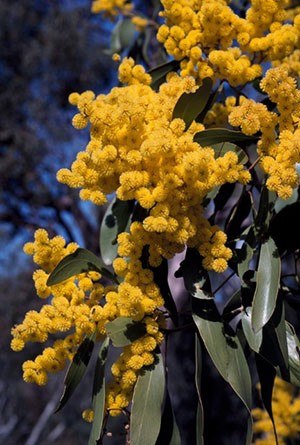On the first day of September each year, Australians wear sprays of wattle to celebrate National Wattle Day. National Wattle Day was officially proclaimed on 23 June 1992 by the then Governor-General of Australia, His Excellency the Honourable Bill Hayden AC. Before then, Australians in different states and territories celebrated Wattle Day on various days between July and September dating back to 1 September 1910.
There are more than 1,000 different species of wattle in Australia, of which some are in flower every month of the year. Wattles flourish in environments which range from the humid tropics to dry deserts and from the coast to the Snowy Mountains. Whilst there are many wattle species in Australia, the golden wattle (Acacia pycnantha) is recognised as Australia’s floral emblem.
The golden wattle is an evergreen shrub or small tree that grows naturally in the understory of open forest and scrubland in South Australia, Victoria, New South Wales and the Australian Capital Territory. In south-eastern Australia, the golden wattle blooms in September with sweetly scented large, fluffy, bright yellow flower heads, each made up of up to 80 tiny flowers forming a mass of pollen-rich stamens.
Wattle is resilient to cope with Australia’s droughts, winds and bushfires. Most species of wattle have tough, leaf-like flattened stems called phyllodes instead of leaves. These help the plants to withstand water loss through sun and wind.
Even if the parent plants are destroyed in bushfires, their seeds have a special survival mechanism to ensure new wattle plants grow back after sufficient rain. The wattle’s secret for survival is that its seeds have tough coats that open after the heat of fires. Just like the Australian people, the golden wattle has a great capacity to flourish in the face of adversity.

The search for a national floral emblem
The idea of the golden wattle as the national floral emblem arose in the 1890s in the search for a national identity, generated by the approach of federation. In the early 1900s, the Wattle Day League was established with the principal objective of promoting a sense of national pride and unity through the wattle flower.
In 1912, the then Prime Minister Andrew Fisher suggested that wattle be included in the new Commonwealth Coat of Arms.
Wattle has been used in the design of Australian stamps and the most recent banknotes, as well as for many awards in the Australian Honours system. The Order of Australia is modelled on a round wattle flower head, and the 1939 to 1945 Civilian Service Medal and the insignia for the Group Citation for Bravery both use the wattle as a major element in their designs.
Although there had been a history of celebrating Wattle Day in Australia, those celebrations were not coordinated and recognition of the wattle was somewhat fragmented. The Wattle Day League encouraged celebration on 1 September and many parts of Australia did so. However, some places celebrated Wattle Day on 1 August.
The power of one
Mrs Maria Hitchcock of Armidale, New South Wales, lobbied the Government for over 5 years and was instrumental in having the golden wattle formally proclaimed as Australia’s national floral emblem in 1988.
Continuing her quest, Mrs Hitchcock sought the agreement of all states and territories to a single day of celebration each year for Wattle Day. In June 1992, her persistence was rewarded with the proclamation of the first day of September each year as Wattle Day, the first day of the Australian spring.
Permission to use
There are no legislative requirements surrounding use of the floral emblem.
